Ontario strikes deal to buy land needed for GO train service enhancement
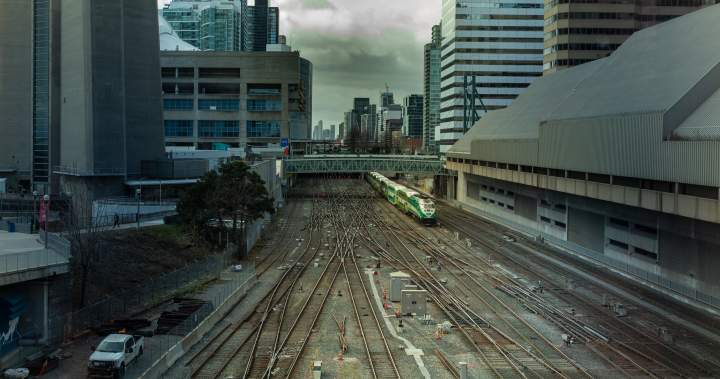
The Ford government says it has reached an agreement with CN Rail to buy the land it needs for more train tracks on the Kitchener GO Line, paving the way for the enhancement of service to and from Toronto.
The announcement is a major moment in a long process which will allow provincial transit agency Metrolinx to add more capacity to the existing route so passenger and freight trains can operate at the same time.
“Today, we’re taking two pivotal steps towards delivering two-way, all-day GO train service between Kitchener and Toronto,” Transportation Minister Prabmeet Sarkaria said in a statement, also referring to the introduction of weekend service.
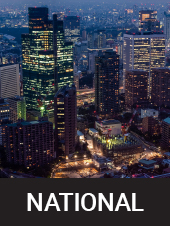
Get daily National news
Get the day’s top news, political, economic, and current affairs headlines, delivered to your inbox once a day.
For years, Metrolinx has been working toward the ultimate goal of two-way, all-day service across its train network, with several areas held back by ownership complications.
Large parts of the track GO trains run on between Kitchener and Toronto are owned by CN Rail, which allows the province to run passenger service at certain times. Without owning the track, Ontario has been at the whims of the freight schedule when trying to increase service.
The announcement on Thursday of the “agreement-in-principle” will allow Metrolinx to purchase land owned by CN along the corridor to build its own tracks. In total, the province will build 40 km of track, it said, along with signalling and other upgrades.
The government said its eventual target was to run two-way, all-day GO service across the Kitchener line at different frequencies.
It is aiming for 15-minute service on the part of the line between Toronto and Bramalea, where Metrolinx already owns the track. Trains out to Mount Pleasant GO would run every 30 minutes, and routes running to Kitchener would be every hour.
It’s not yet clear when the land will be purchased, track constructed or service ramped up.
Beginning at the end of November, however, the government will ramp up service on the track section it owns between Toronto and Bramalea.
From Nov. 23 onwards, service will be introduced every 30 minutes over the weekend, along with other service enhancements.
© 2025 Global News, a division of Corus Entertainment Inc.

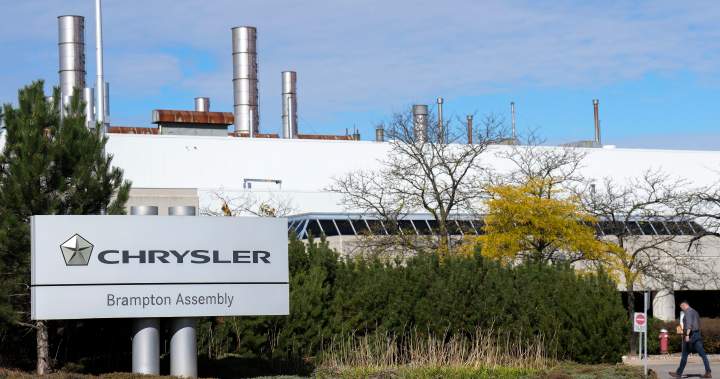
The union representing workers at a shuttered Brampton, Ont., auto assembly plant has blasted the decision to move 3,000 jobs to the United States as “an egregious violation” of the agreement the company signed.
A fiery statement from Unifor, published Friday, lambasted Stellantis for moving Jeep production out of Ontario and into the United States, accusing the company of breaking its agreement with thousands of workers.
“Stellantis’ actions are appalling,” the statement said.
“Since February 2025, when the company first notified the union of delays in Brampton Assembly Plant retooling and J4U program implementation, Unifor sought clarity on the company’s reasons, as well as timelines for work to restart. For 8 months, company representatives reassured us that the vehicle commitment to Brampton was unchanged.”
The announcement came earlier this week, when Stellantis unveiled a $13-billion investment in the United States amidst tariffs.
The federal government has threatened the company with legal action. It is currently in line to receive large subsidies from both the provincial and federal governments.

Get breaking National news
For news impacting Canada and around the world, sign up for breaking news alerts delivered directly to you when they happen.
Prime Minister Mark Carney said Thursday that the global head of Stellantis told him the automaker is looking at finding a new model to fill the idled Brampton plant, but that a decision would require more trade certainty.
“They’re looking at different models being produced in Brampton. That decision would be taken in the context of the finalization of the USMCA,” he told reporters.
Unifor, however, said it had not been given any indication that Stellantis was proceeding with the plan and demanded certainty for local jobs.
“To be clear, Unifor has not been notified of any alternative plans for production at Brampton. There is no reason to treat these public statements as credible, or reliable,” the statement continued.
“And further, the federal government is not the legal bargaining agent for Brampton Assembly Plant workers. Any future conversations about the future of Brampton Assembly Plant must include Unifor.”
Unifor is the country’s largest private sector union, and also represents staff working at Global News.
Stellantis had been in the middle of retooling its Brampton plant to assemble new vehicles earlier this year. It paused that work in the face of U.S. President Donald Trump’s auto tariffs.
Now, the Jeep Compass — which was slated to be made in Brampton — will be made in Belvidere, Ill.
The company stressed in a statement that it remained committed to Canadian jobs and hinted it could find a future for its Brampton operation.
“Canada is very important to us,” the company said. “We have plans for Brampton and will share them upon further discussions with the Canadian government.”
Unifor said it was not satisfied with the statements.
“Stellantis’ actions this week are a blackmark on the company’s 100-year history of automaking in Canada,” the union wrote. “The company has betrayed the union’s trust, the trust of its workforce, and of all Canadians. This behaviour will not be tolerated by Unifor.”
Stellantis’ $13 billion announcement involves producing vehicles in Illinois, Ohio, Michigan and Indiana, and reduces its focus on electrification.
© 2025 Global News, a division of Corus Entertainment Inc.
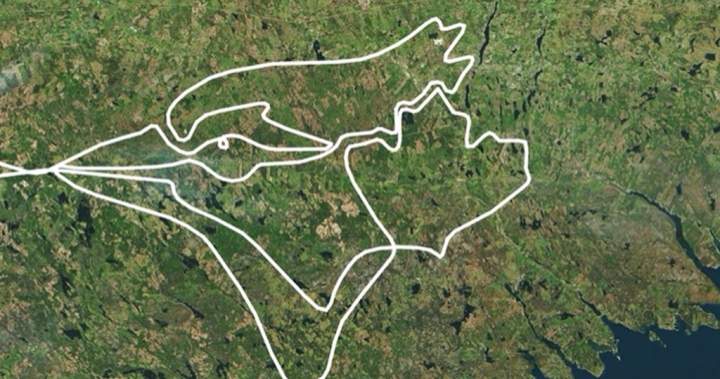
A Halifax pilot and longtime Blue Jays fan has taken his support for Canada’s baseball team to new heights — literally — tracing the team’s logo through the skies over Nova Scotia.
“I wanted to cheer on the Blue Jays, I wanted to cheer the fans, I wanted to do it for myself,” said Dimitri Neonakis.
The two-and-a-half-hour trip, Neonakis says, took about three hours to plan and map out before he took off from Halifax Stanfield International Airport at 11:27 a.m. local time Tuesday.
Related Videos
He began by outlining the maple leaf — the trickiest part, he says — before carefully tracing the bird in the team’s logo with his Cirrus SR22 aircraft. His route stretched roughly 570 kilometres, looping from Halifax to the town of Debert and back.

Get breaking National news
For news impacting Canada and around the world, sign up for breaking news alerts delivered directly to you when they happen.
While still in the air tracing the bird, Neonakis says someone messaged to ask if he was the one behind the drawing.
“I said, ‘I’m a big fan. Of course I did,” he said with a laugh.
The pilot of 27 years says this flight path has drawn more attention than most online, but it isn’t his first of its kind.
He says he has completed nearly 30 of these “sky drawings,” some in support of missing children or to honour people such as George Floyd, Terry Fox and Jennifer Casey, the Snowbirds member killed in a 2020 crash.
Occasionally, like with the Jays, he takes to the air for fun — sketching hearts, holiday greetings or Father’s Day wishes.
This report by The Canadian Press was first published Oct. 17, 2025.
© 2025 The Canadian Press
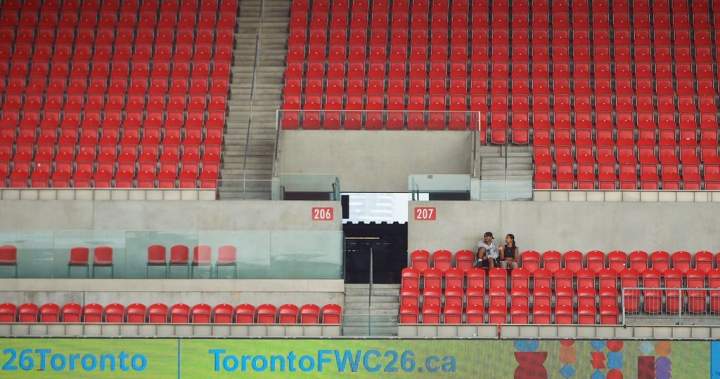
Toronto Public Health is developing a wastewater surveillance program to detect the spread of diseases during the FIFA World Cup.
Toronto’s new Medical Officer of Health Dr. Michelle Murti said the pilot will collect sewage samples in areas where fans congregate and test them to detect diseases, such as COVID-19, influenza and RSV.
Murti said the public health unit is looking into whether other illnesses, such as measles, could also be monitored in wastewater given the large international audience that will be congregating in Toronto next summer.
“It’ll just be one more piece of information that we have as part of a larger suite of information that we’re looking at to make sure that we’re keeping people safe and healthy through the games,” Murti said.
The city has said it expects 300,000 out-of-town visitors in Toronto over the course of six World Cup matches starting in June.
Ontario’s COVID-19 wastewater surveillance program, which provided a close to real-time way to track the prevalence of the virus before people showed symptoms during the pandemic, ended last year.

Get breaking National news
For news impacting Canada and around the world, sign up for breaking news alerts delivered directly to you when they happen.
Dr. Fahad Razak, an internal medicine specialist at St. Michael’s Hospital, said applying this technology to a large scale event like the World Cup is an innovative approach to fill the gap left since the provincial program concluded.
Razak said that program should have been sustained and the disease detection potential of the technology should have been explored beyond COVID-19.
For example, Windsor-Essex County used wastewater surveillance earlier this year to detect a rise in measles infections within the region.
“Measles is a very good example because it is an illness that is so transmissible. If you have a high pocket of unprotected people and you have the emergence of the measles signal within that area, that’s an area where you’d want to do your best from a public health perspective to try and prevent spread,” Razak said.
Razak said wastewater could also be used for opioid surveillance to detect a contaminated drug supply during the World Cup.
“The idea here is – can you use it to make decisions and to intervene in a way that saves people’s lives or reduces illness? That’s the critical question.”
Dr. Lawrence Goodridge, co-lead of the Guelph Wastewater Epidemiology Lab for Public Health, said the province’s decision to end its wastewater program, which monitored 75 per cent of the population, has necessitated smaller scale programs like this one.
The pilot will be useful if a major outbreak spreads at the games, but the drawback is that the reach is limited, he said.
“People are going to be moving around, they’re coming into Toronto, but they’re also going to be moving around through the province for the World Cup,” Goodridge said.
Toronto’s top doctor said the pilot will help determine the value of wastewater surveillance for future large-scale events in the city.
© 2025 The Canadian Press
-

 Uncategorized4 months ago
Uncategorized4 months agoShop Proud, Eat Proud, Be Proud — Ottawa Canada Day Market This June 28th
-
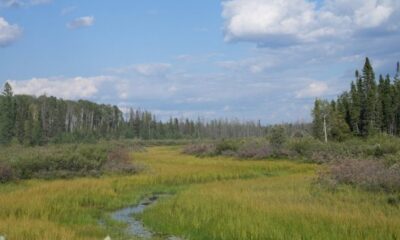
 4 months ago
4 months agoRing of Fire road to bring prosperity to First Nation, problems for caribou: report
-
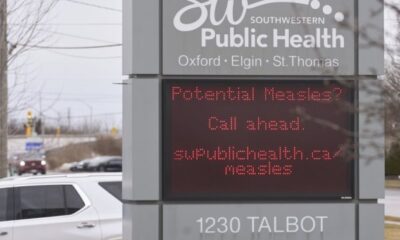
 4 months ago
4 months agoMeasles circulating in northeastern B.C. community, health officials warn
-

 4 months ago
4 months agoCanada’s world junior trial saw juries tossed, intense testimony. Here’s a recap
-

 4 months ago
4 months agoFormer major leaguer, Jays doctor Ron Taylor dies
-

 4 months ago
4 months agoJagmeet Singh apologizes for attending Kendrick Lamar concert after Drake calls him out
-

 4 months ago
4 months agoAnishinabek Nation chief says he briefed Ontario police on protests against Bill 5
-
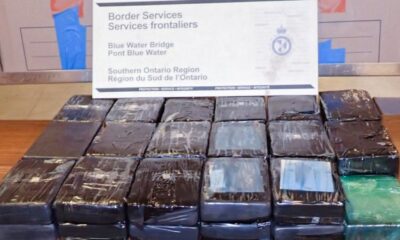
 4 months ago
4 months ago161 bricks of suspected cocaine found on truck trying to cross Canada-U.S. border







